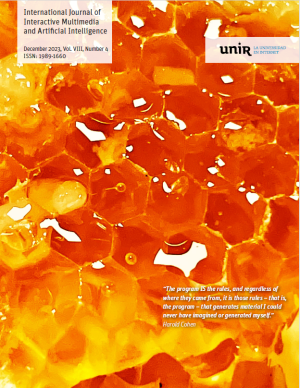Results of a Study to Improve the Spanish Version of the User Experience Questionnaire (UEQ).
DOI:
https://doi.org/10.9781/ijimai.2022.11.003Keywords:
Evaluation, Questionnaire, User ExperienceAbstract
This paper analyses changes in some items of the User Experience Questionnaire (UEQ) for use in the context of Costa Rican culture. Although a Spanish version of the UEQ was created in 2012, we use a double-translation and reconciliation model for detecting the more appropriate words for Costa Rican culture. These resulted in 7 new items that were added to the original Spanish version. In total, the resulting UEQ had 33 items. 161 participants took part in a study that examined both the original items and the new ones. Static analyses (Cronbach's Alpha, mean, variance, and confidence interval) were performed to measure the differences of the scales of the original items and the new UEQ variant with the Costa Rican words. Finally, confidence intervals of the individual items and Cronbach’s Alpha coefficient average of the affected scales were analysed. The results show, contrary to initial expectations, that the Costa Rican word version is neither better nor worse than the original Spanish version. However, this shows that the UEQ is very robust to some changes in the items.
Downloads
References
ISO 9241-210, “Ergonomics of human-system interaction - part 210: Human-centred design for interactive systems,” International Organization for Standardization, Geneva, Switzerland, 2019.
J. Lazar, J.H. Feng, and H. Hochheiser, Research methods in human-computer interaction, 2nd ed., Glasgow, United Kingdom: Bell & Brain, 2010.
M. Minge, and L. Riedel, “meCUE – Ein modularer Fragebogen zur Erfassung des Nutzungserlebens [meCue – A modular questionnaire for capturing the user experience],” in S. Boll, S. Maaß and R. Malaka (Ed.): Mensch und Computer [Humans and computers] 2013: Interaktive Vielfalt [Interactive diversity], Oldenbourg Verlag, München, pp. 89-98, 2013.
J. Sauro, “SUPR-Q: A comprehensive measure of the quality of the website user experience,” Journal of Usability Studies, vol. 10, no. 2, pp. 68–86, 2015, doi: 10.5555/2817315.2817317.
B. Laugwitz, M. Schrepp, and T. Held, “Konstruktion eines Fragebogens zur Messung der User Experience von Softwareprodukten [Construction of a questionnaire for the measurement of user experience of software products],” in A.M. Heinecke and H. Paul (Eds.): Mensch & Computer [Humans & computers] 2006, Oldenbourg Verlag, pp. 125–134, 2006.
B. Laugwitz, T. Held, and M. Schrepp , “Construction and evaluation of a user experience questionnaire,” in Symposium of the Austrian HCI and Usability Engineering Group, Heidelberg, Germany, pp. 63-76, 2008, doi: 10.1007/978-3-540-89350-9_6.
M. Thielsch and M. Mooshgen, “Erfassung visueller Ästhetik mit dem VISAWI,” Usability Professionals 2011, Stuttgart, Germany, pp. 260-265, 2011.
M. Thielsch and G. Hirschfeld, “Facets of website content,” Human– Computer Interaction, vol. 34, no.4, pp. 279–327, 2019.
American Educational Research Association, American Psychological Association, & National Council on Measurement in Education, “Standards for educational and psychological testing,” American Educational Research Association, 1999.
M. Rauschenberger, M. Schrepp, S. Olschner, J. Thomaschewski, and MP. Cota, “Measurement of user experience: A Spanish Language Version of the User Experience Questionnaire (UEQ),” In: Á.J.A. Rocha, L.P.R. CalvoManzano, M. Pérez Cota (editors), Information Systems and Technologies (CISTI), Madrid, Spain, pp. 471-476, 2012.
M. Rauschenberger, M. Schrepp, MP. Cota, S. Olschner, and J. Thomaschewski, “Efficient measurement of the user experience of interactive products - How to use the User Experience Questionnaire (UEQ). Example: Spanish Language Version,” International Journal of Interactive Multimedia and Artificial Intelligence, vol. 2, no. 1, pp. 39-45, 2013, doi: 10.9781/ijimai.2013.215.
M. Schrepp, A. Hinderks, and J. Thomaschewski, “Construction of a Benchmark for the User Experience Questionnaire (UEQ),” International Journal of Interactive Multimedia and Artificial Intelligence, vol. 4, no. 4, pp. 40-44, 2017, doi: 10.9781/ijimai.2017.445.
A. Hinderks, M. Schrepp, F. J. Domínguez Mayo, M. J. Escalona, and J. Thomaschewski, “Developing a UX KPI based on the user experience questionnaire,” Computer Standards & Interfaces, no. 65, pp. 38–44, 2019, doi: 10.1016/j.csi.2019.01.007.
International Test Commission, “The ITC Guidelines for Translating and Adapting Tests (Second edition),” 2017. Accessed: June 14 2021. [Online]. Available: https://www.intestcom.org/files/guideline_test_adaptation_2ed.pdf
D.B. Bonett, “Sample Size Requirements for Testing and Estimating Coefficient Alpha,” Journal of Educational and Behavioral Statistics, vol. 27, no. 4, pp. 335-340, 2002, doi: 10.3102/10769986027004335
M. Schrepp, “On the Usage of Cronbach’s Alpha to Measure Reliability of UX Scales,” Journal of Usability Studies, vol. 15, no. 4, pp. 247–258, 2020.
M. Schrepp, and J. Thomaschewski, “Design and Validation of a Framework for the Creation of User Experience Questionnaires,” International Journal of Interactive Multimedia and Artificial Intelligence, vol. 5, no. 7, 2019, pp. 88-95, doi: 10.9781/ijimai.2019.06.006.
M. Schrepp, R. Otten, K. Blum, and J. Thomaschewski, “What Causes the Dependency between Perceived Aesthetics and Perceived Usability?,” International Journal of Interactive Multimedia and Artificial Intelligence, vol. 6, no. 6, pp. 78-85, 2021, doi: 10.9781/ijimai.2020.12.005.
A.-L. Meiners, J. Kollmorgen, M. Schrepp, and J. Thomaschewski, “Which UX Aspects Are Important for a Software Product?,” In: S. Schneegass, B. Pfleging, and D. Kern (editors): Mensch und Computer (MuC), Ingolstadt, Germany, pp. 136–139, 2021.
Downloads
Published
-
Abstract251
-
PDF64









